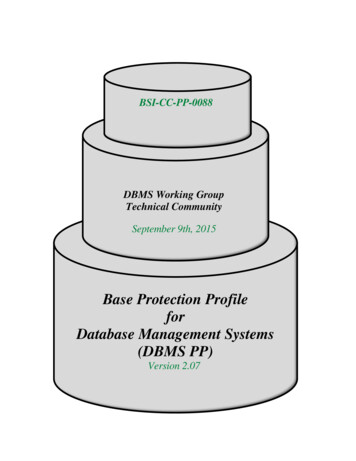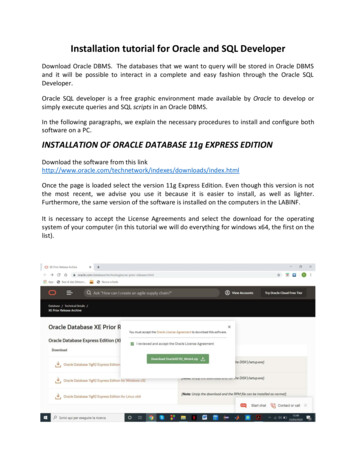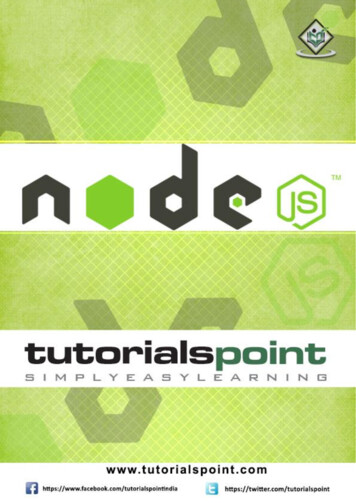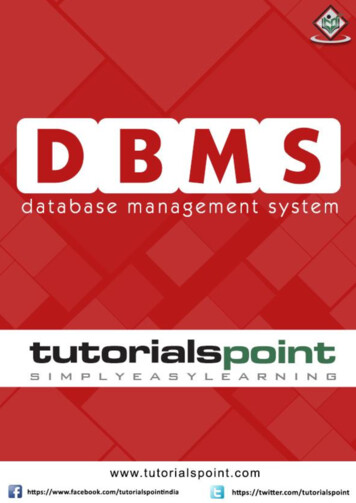
Transcription
DBMSAbout the TutorialDatabase Management System or DBMS in short refers to the technology ofstoring and retrieving users’ data with utmost efficiency along with appropriatesecurity measures. DBMS allows its users to create their own databases as pertheir requirement. These databases are highly configurable and offer a bunch ofoptions.This tutorial explains the basics of DBMS such as its architecture, data models,data schemas, data independence, E-R model, relation model, relational databasedesign, and storage and file structure. In addition, it covers a few advanced topicssuch as indexing and hashing, transaction and concurrency, and backup andrecovery.AudienceThis tutorial will especially help computer science graduates in understanding thebasic-to-advanced concepts related to Database Management Systems.PrerequisitesBefore you start proceeding with this tutorial, it is recommended that you have agood understanding of basic computer concepts such as primary memory,secondary memory, and data structures and algorithms.Copyright & Disclaimer Copyright 2015 by Tutorials Point (I) Pvt. Ltd.All the content and graphics published in this e-book are the property of TutorialsPoint (I) Pvt. Ltd. The user of this e-book is prohibited to reuse, retain, copy,distribute or republish any contents or a part of contents of this e-book in anymanner without written consent of the publisher.We strive to update the contents of our website and tutorials as timely and asprecisely as possible, however, the contents may contain inaccuracies or errors.Tutorials Point (I) Pvt. Ltd. provides no guarantee regarding the accuracy,timeliness or completeness of our website or its contents including this tutorial. Ifyou discover any errors on our website or in this tutorial, please notify us atcontact@tutorialspoint.comi
DBMSTable of ContentsAbout the Tutorial . iAudience . iPrerequisites . iCopyright & Disclaimer . iTable of Contents . ii1. OVERVIEW . 1Characteristics . 1Users . 22. ARCHITECTURE . 43-tier Architecture . 43. DATA MODELS . 6Entity-Relationship Model . 6Relational Model . 74. DATA SCHEMAS . 9Database Schema. 9Database Instance. 105. DATA INDEPENDENCE . 11Data Independence . 11Logical Data Independence . 11Physical Data Independence . 126. ER MODEL – BASIC CONCEPTS . 13Entity . 13Attributes . 13ii
DBMSRelationship . 147. ER DIAGRAM REPRESENTATION . 17Entity . 17Attributes . 17Relationship . 198. GENERALIZATION & SPECIALIZATION . 22Generalization . 22Specialization . 22Inheritance . 239. CODD’S 12 RULES. 25Rule 1: Information Rule . 25Rule 2: Guaranteed Access Rule . 25Rule 3: Systematic Treatment of NULL Values . 25Rule 4: Active Online Catalog . 25Rule 5: Comprehensive Data Sub-Language Rule . 25Rule 6: View Updating Rule . 26Rule 7: High-Level Insert, Update, and Delete Rule . 26Rule 8: Physical Data Independence. 26Rule 9: Logical Data Independence . 26Rule 10: Integrity Independence . 26Rule 11: Distribution Independence . 26Rule 12: Non-Subversion Rule . 2610. RELATIONAL DATA MODEL . 27Concepts . 27Constraints. 27iii
DBMS11. RELATIONAL ALGEBRA. 29Relational Algebra . 29Relational Calculus . 3112. ER MODEL TO RELATIONAL MODEL . 33Mapping Entity . 33Mapping Relationship . 34Mapping Weak Entity Sets . 34Mapping Hierarchical Entities . 3513. SQL OVERVIEW. 37Data Definition Language . 37Data Manipulation Language . 3814. NORMALIZATION . 41Functional Dependency . 41Armstrong's Axioms . 41Trivial Functional Dependency . 41Normalization . 42First Normal Form . 42Second Normal Form . 43Third Normal Form. 44Boyce-Codd Normal Form . 4515. JOINS. 46Theta (θ) Join . 46Equijoin . 47Natural Join ( ) . 47Outer Joins . 49iv
DBMS16. STORAGE SYSTEM . 52Memory Hierarchy . 52Magnetic Disks . 53RAID . 5317. FILE STRUCTURE. 56File Organization . 56File Operations. 5718. INDEXING . 59Dense Index . 59Sparse Index . 60Multilevel Index . 60B Tree . 6119. HASHING . 63Hash Organization. 63Static Hashing . 63Bucket Overflow . 64Dynamic Hashing . 65Organization . 66Operation . 6620. TRANSACTION . 68ACID Properties. 68Serializability . 69Equivalence Schedules . 69States of Transactions . 7121. CONCURRENCY CONTROL . 72v
DBMSLock-based Protocols . 72Timestamp-based Protocols . 74Timestamp Ordering Protocol . 7422. DEADLOCK . 76Deadlock Prevention . 76Deadlock Avoidance. 7723. DATA BACKUP . 79Loss of Volatile Storage . 79Database Backup & Recovery from Catastrophic Failure . 79Remote Backup . 8024. DATA RECOVERY . 81Crash Recovery . 81Failure Classification . 81Storage Structure . 82Recovery and Atomicity . 82Log-based Recovery . 83Recovery with Concurrent Transactions . 83vi
1. OVERVIEWDBMSDatabase is a collection of related data and data is a collection of facts and figuresthat can be processed to produce information.Mostly data represents recordable facts. Data aids in producing information, which isbased on facts. For example, if we have data about marks obtained by all students,we can then conclude about toppers and average marks.A database management system stores data in such a way that it becomes easierto retrieve, manipulate, and produce information.CharacteristicsTraditionally, data was organized in file formats. DBMS was a new concept then, andall the research was done to make it overcome the deficiencies in traditional style ofdata management. A modern DBMS has the following characteristics: Real-world entity: A modern DBMS is more realistic and uses real-worldentities to design its architecture. It uses the behavior and attributes too. Forexample, a school database may use students as an entity and their age as anattribute. Relation-based tables: DBMS allows entities and relations among them toform tables. A user can understand the architecture of a database just bylooking at the table names. Isolation of data and application: A database system is entirely differentthan its data. A database is an active entity, whereas data is said to be passive,on which the database works and organizes. DBMS also stores metadata, whichis data about data, to ease its own process. Less redundancy: DBMS follows the rules of normalization, which splits arelation when any of its attributes is having redundancy in values.Normalization is a mathematically rich and scientific process that reduces dataredundancy. Consistency: Consistency is a state where every relation in a databaseremains consistent. There exist methods and techniques, which can detectattempt of leaving database in inconsistent state. A DBMS can provide greater7
DBMSconsistency as compared to earlier forms of data storing applications like fileprocessing systems. Query Language: DBMS is equipped with query language, which makes itmore efficient to retrieve and manipulate data. A user can apply as many andas different filtering options as required to retrieve a set of data. Traditionallyit was not possible where file-processing system was used. ACID Properties: DBMS follows the concepts of Atomicity, Consistency,Isolation, and Durability (normally shortened as ACID). These concepts areapplied on transactions, which manipulate data in a database. ACID propertieshelp the database stay healthy in multi-transactional environments and in caseof failure. Multiuser and Concurrent Access: DBMS supports multi-user environmentand allows them to access and manipulate data in parallel. Though there arerestrictions on transactions when users attempt to handle the same data item,but users are always unaware of them. Multiple views: DBMS offers multiple views for different users. A user who isin the Sales department will have a different view of database than a personworking in the Production department. This feature enables the users to havea concentrate view of the database according to their requirements. Security: Features like multiple views offer security to some extent whereusers are unable to access data of other users and departments. DBMS offersmethods to impose constraints while entering data into the database andretrieving the same at a later stage. DBMS offers many different levels ofsecurity features, which enables multiple users to have different views withdifferent features. For example, a user in the Sales department cannot see thedata that belongs to the Purchase department. Additionally, it can also bemanaged how much data of the Sales department should be displayed to theuser. Since a DBMS is not saved on the disk as traditional file systems, it isvery hard for miscreants to break the code.UsersA typical DBMS has users with different rights and permissions who use it for differentpurposes. Some users retrieve data and some back it up. The users of a DBMS canbe broadly categorized as follows:8
DBMS[Image: DBMS Users] Administrators: Administrators maintain the DBMS and are responsible foradministrating the database. They are responsible to look after its usage andby whom it should be used. They create access profiles for users and applylimitations to maintain isolation and force security. Administrators also lookafter DBMS resources like system license, required tools, and other softwareand hardware related maintenance. Designers: Designers are the group of people who actually work on thedesigning part of the database. They keep a close watch on what data shouldbe kept and in what format. They identify and design the whole set of entities,relations, constraints, and views. End Users: End users are those who actually reap the benefits of having aDBMS. End users can range from simple viewers who pay attention to the logsor market rates to sophisticated users such as business analysts.9
2. ARCHITECTUREDBMSThe design of a DBMS depends on its architecture. It can be centralized ordecentralized or hierarchical. The architecture of a DBMS can be seen as either singletier or multi-tier. An n-tier architecture divides the whole system into related butindependent n modules, which can be independently modified, altered, changed, orreplaced.In 1-tier architecture, the DBMS is the only entity where the user directly sits on theDBMS and uses it. Any changes done here will directly be done on the DBMS itself.It does not provide handy tools for end-users. Database designers and programmersnormally prefer to use single-tier architecture.If the architecture of DBMS is 2-tier, then it must have an application through whichthe DBMS can be accessed. Programmers use 2-tier architecture where they accessthe DBMS by means of an application. Here the application tier is entirely independentof the database in terms of operation, design, and programming.3-tier ArchitectureA 3-tier architecture separates its tiers from each other based on the complexity ofthe users and how they use the data present in the database. It is the most widelyused architecture to design a DBMS.10
DBMS[Image: 3-tier DBMS architecture] Database (Data) Tier: At this tier, the database resides along with its queryprocessing languages. We also have the relations that define the data and theirconstraints at this level.11
DBMSEnd of ebook previewIf you liked what you saw Buy it from our store @ https://store.tutorialspoint.com12
A database management system stores data in such a way that it becomes easier to retrieve, manipulate, and produce information. Characteristics Traditionally, data was organized in file formats. DBMS was a new concept then, and all the research was done to make it overcome the deficiencies in traditional style of data management.

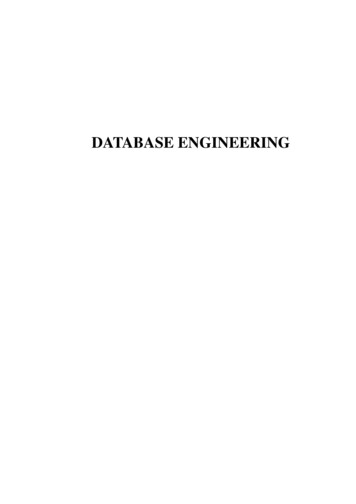


![Database Management System [DBMS] Tutorial](/img/2/dbms-tutorial.jpg)


